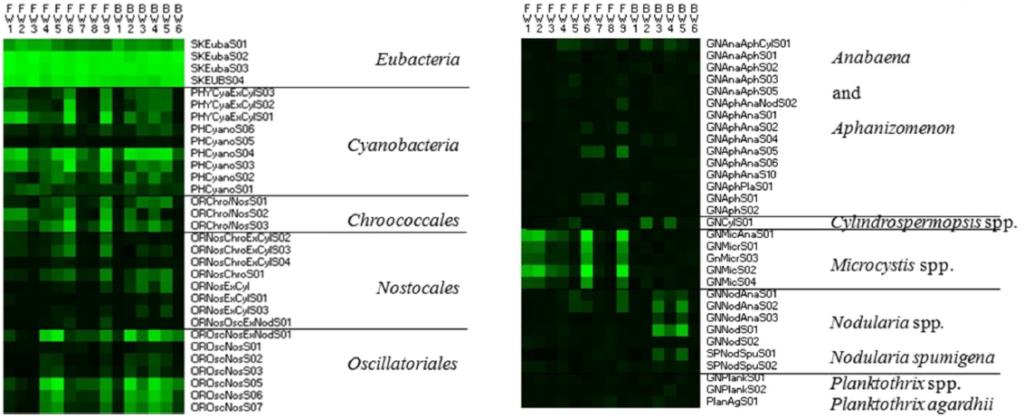Articles les plus marquants concernant la technologie des biocapteurs Microbia Environnement
2022
Citation des kits CARLA dans :
Gong P., Antrim A.K., Bickman S.R., Cooley E.G., Chung S.H., 2022. Sandwich Hybridization Assay for In Situ Real-Time Cyanobacterial Detection and Monitoring: A Review. Biosensors (8):640. DOI 10.3390/bios12080640
URL https://www.mdpi.com/2079-6374/12/8/640/pdf?version=1660475206
2021
Moreira S., Laplace-Treyture C., Costa M., Eon M., Guillebault D., Millan-Navarro D., Pasero E., Ritter L., 2021. CYANOSAFE : Etude des risques liés aux efflorescences de cyanobactéries potentiellement toxiques. Cours d’eau du Boudigau : du Marais d’Orx à son exutoire. Rapport Inrae, Gazinet. 69p.
URL https://hal.inrae.fr/hal-03331992/document
Robla J., García-Hierrro J., Alguacil F. J., Dittami S. M., Marie, D, Villa E., E. Mengs G. & Medlin L.K. (2021). Determination of the efficiency of filtration of cultures from microalgae and bacteria using hollow fiber filters. Environmental Science: Water Research & Technology.
2020
Guillebault D. & Medlin L.K. (2020). Application of the μAqua microarray for pathogenic organisms across a marine/freshwater interface. Harmful Algae, 92, 101703.
2019
Dermastia T.T., Villa E., Guillebault D., Mozetič P. & Francé J. (May 2019). Sandwich hybridization-based genosensor for high-throughput detection of toxic marine diatoms from the Pseudo-nitzschia genus (May 2019). Poster – 11th Jožef Stefan International Postgraduate School Students’ Conference.
DOI 10.13140/RG.2.2.11083.64805
Danchenko S., Fragoso B., Guillebault D., Icely J., Berzano M. & Newton A. (2019). Harmful phytoplankton diversity and dynamics in an upwelling region (Sagres, SW Portugal) revealed by ribosomal RNA microarray combined with microscopy. Harmful Algae, 82, 52-71.
2018
Van de Waal D.B., Guillebault D., Alfonso A., Rodríguez I., Botana L.M., Bijkerk R., & Medlin L.K. (2018). Molecular detection of harmful cyanobacteria and expression of their toxin genes in Dutch lakes using multi-probe RNA chips. Harmful Algae, 72, 25-35.
Akçaalan R., Albay M., Koker L., Baudart J., Guillebault D., Fischer S., Weigel W. & Medlin L.K. (2018). Seasonal dynamics of freshwater pathogens as measured by microarray at Lake Sapanca, a drinking water source in the north-eastern part of Turkey. Environmental Monitoring and Assessment, 190(1), 42.
Herard F., Sauvagère S., El Amrani A.E.A., Guillebault D., Laplace-Treyture C., Moreira S., Ortega Pizarro A., Rodriguez Cristobal J.M. & Manes C.L. (2018). Sensitive biosensing of potentially toxic cyanobacteria for risk application in freshwater environments. Poster – In 18e ICHA, Nantes, France.
Archive IRSTEA hal.inrae.fr/hal-02607982
2017
Medlin L.K., Guillebault D., Mengs G., Garbi C., Dejana L., Fajardo C. & Martin M. (2017). New molecular tools: application of the μAQUA phylochip and concomitant FISH probes to study freshwater pathogens from samples taken along the Tiber River, Italy. In River Basin Management IX. WIT Transactions on Ecology and the Environment, Vol 221, p-109. (ISBN 1784662070, 9781784662073)
Danchenko S., Fragoso B., Guillebault D., Icely J., Berzano M. & Newton A. (May 2017) Application of 18S RNA microarray complemented by microscopy to study dynamics of harmful phytoplankton in an upwelling region with shellfish aquaculture (Sagres, Portugal). Poster – The application of population genomics to fisheries management. Faro, Portugal.
Baudart J., Guillebault D., Mielke E., Meyer T., Tandon N., Fischer S., Weigel W. & Medlin, L.K. (2017). Microarray (phylochip) analysis of freshwater pathogens at several sites along the Northern German coast transecting both estuarine and freshwaters. Applied Microbiology and Biotechnology, 101(2), 871-886.
Rodriguez I., Fraga M., Alfonso A., Guillebault D., Medlin L.K., Baudart J., Jacob P., Helmi K., Meyer T., Breitenbach U., Holden N.M., Boots B., Spurio R., Cimarelli L., Mancini L., Marcheggiani S., Albay M., Akcaalan R., Köker L. & Botana L.M. (2017). Monitoring of freshwater toxins in European environmental waters by using novel multi-detection methods: Two ATX-a analogues detected in freshwater. Environmental Toxicology and Chemistry, 36(3), 645-654.
DOI 10.1002/etc.3577
2016
Orozco J., Villa E., Manes C.L., Medlin L.K. & Guillebault D. (2016). Electrochemical RNA genosensors for toxic algal species: enhancing selectivity and sensitivity. Talanta 161, 560-566.
DOI 10.1016/j.talanta.2016.08.073
Greer B., McNamee S.E., Boots B., Cimarelli L., Guillebault D., Helmi K., Marcheggiani S., Panaiotov S., Breitenbach U., Akçaalan R., Medlin L.K., Kittler K., Elliott C.T. & Campbell K. (2016) A validated UPLC–MS/MS method for the surveillance of ten aquatic biotoxins in European brackish and freshwater systems. Harmful Algae, 55, 31–40.
D’Ugo E., Marcheggiani S., Fioramont I., Giuseppetti R., Spurio R., Helmi K., Guillebault D., Medlin L.K., Simeonovski I., Boots B., Breitenbach U, Koker L., Albay M. & Mancini L. Detection of Human Enteric Viruses in Freshwater from European Countries. Food and Environmental Virology 8(3), 206-214.
Lemonnier H., Lantoine F., Courties C., Guillebault D., Nézan E., Chomérat N., Escoubeyrou K., Galinié C., Blockmans B. & Laugier T. (2016). Dynamics of phytoplankton communities in eutrophying tropical shrimp ponds affected by vibriosis. Marine pollution bulletin, 110(1), 449-459.
DOI 10.1016/j.marpolbul.2016.06.015
Kegel J.U., Guillebault D. & Medlin L.K. (2016). Application of microarrays (phylochips) for analysis of community diversity by species identification. Perspectives in Phycology, 3(2), 93-106.
2015
Marcheggiani S., D’Ugo E., Puccinelli C., Giuseppetti R., D’Angelo A.M., Gualerzi C.O., Medlin L.K., Guillebault D., Weigel W., Helmi, K. & Mancini L. (2015). Detection of emerging and re-emerging pathogens in surface waters close to an urban area. International Journal of Environmental Research and Public Health, 12(5), 5505-5527.

